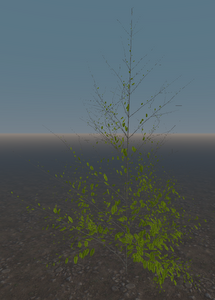Information
- Publication Type: Bachelor Thesis
- Workgroup(s)/Project(s):
- Date: December 2023
- Date (Start): November 2021
- Date (End): December 2023
- Matrikelnummer: 0271409
- First Supervisor: Michael Wimmer
- Keywords: rendering, modeling, plant
Abstract
This bachelor's thesis explores the development of a plugin for the open-source game engine Godot 3.5, aimed at providing an easy way for procedurally creating pleasing plant visualizations, specifically in the frame of the Sustainable Agroecosystem project. This is achieved by importing data conforming to a predefined format that abstractly describes the structure of plant organisms. Upon import, the plugin generates 3D surfaces for the branching structures and employs instancing for rendering leaves efficiently. One of the key features of the plugin is its adaptive surface subdivision mechanism, which dynamically generates the surface at different levels of detail based on the proximity to the camera.The plugin's implementation leverages Godot's GDPlugin feature to seamlessly integrate into the engine's workflow. The procedural generation of plant structures is achieved through algorithmic processes that translate "tree skeletons" into 3D surfaces. However, due to limitations inherent in Godot 3, the adaptive subdivision mechanism is implemented on the CPU. In tests, this resulted in the following: Exports of models in the highest level of detail yielded better performance than models with adaptive subdivision.
The thesis covers the design, implementation, and theory behind the plugin. An evaluation of the plugin's functionality and performance is conducted, highlighting its capability to dynamically adapt the mesh at runtime. Performance comparisons between the adaptive subdivision approach and using the exported surface are presented, revealing the issues with the implementation on the CPU.
In conclusion, the developed plugin presents a novel approach to procedurally generate and render complex plant structures within the Godot 3.5 game engine. It extends the capabilities of the engine in creating realistic virtual environments while addressing the challenges of adaptive subdivision on the CPU. The thesis explores the intricacies of integrating such plugins into game engines and opens avenues for further optimizations.
Additional Files and Images
Weblinks
No further information available.BibTeX
@bachelorsthesis{Grossfurtner-2023-paego,
title = "Generating Aesthetic Plant Models from an Open Data Format
of the Project for Sustainable Agroecosystems in Godot",
author = "Moritz Leander Gro{\ss}furtner",
year = "2023",
abstract = "This bachelor's thesis explores the development of a plugin
for the open-source game engine Godot 3.5, aimed at
providing an easy way for procedurally creating pleasing
plant visualizations, specifically in the frame of the
Sustainable Agroecosystem project. This is achieved by
importing data conforming to a predefined format that
abstractly describes the structure of plant organisms. Upon
import, the plugin generates 3D surfaces for the branching
structures and employs instancing for rendering leaves
efficiently. One of the key features of the plugin is its
adaptive surface subdivision mechanism, which dynamically
generates the surface at different levels of detail based on
the proximity to the camera. The plugin's implementation
leverages Godot's GDPlugin feature to seamlessly integrate
into the engine's workflow. The procedural generation of
plant structures is achieved through algorithmic processes
that translate "tree skeletons" into 3D surfaces. However,
due to limitations inherent in Godot 3, the adaptive
subdivision mechanism is implemented on the CPU. In tests,
this resulted in the following: Exports of models in the
highest level of detail yielded better performance than
models with adaptive subdivision. The thesis covers the
design, implementation, and theory behind the plugin. An
evaluation of the plugin's functionality and performance is
conducted, highlighting its capability to dynamically adapt
the mesh at runtime. Performance comparisons between the
adaptive subdivision approach and using the exported surface
are presented, revealing the issues with the implementation
on the CPU. In conclusion, the developed plugin presents a
novel approach to procedurally generate and render complex
plant structures within the Godot 3.5 game engine. It
extends the capabilities of the engine in creating realistic
virtual environments while addressing the challenges of
adaptive subdivision on the CPU. The thesis explores the
intricacies of integrating such plugins into game engines
and opens avenues for further optimizations.",
month = dec,
address = "Favoritenstrasse 9-11/E193-02, A-1040 Vienna, Austria",
school = "Research Unit of Computer Graphics, Institute of Visual
Computing and Human-Centered Technology, Faculty of
Informatics, TU Wien ",
keywords = "rendering, modeling, plant",
URL = "https://www.cg.tuwien.ac.at/research/publications/2023/Grossfurtner-2023-paego/",
}

 thesis
thesis
